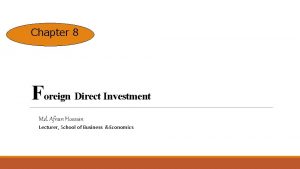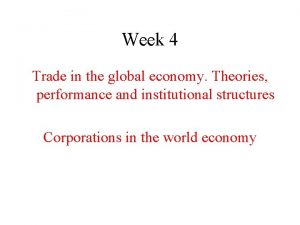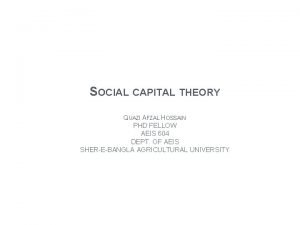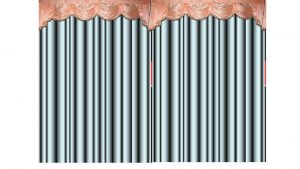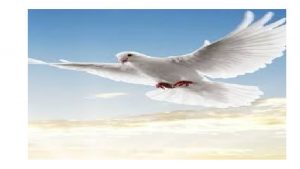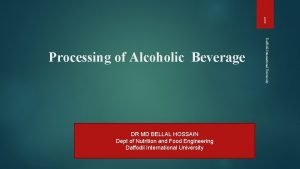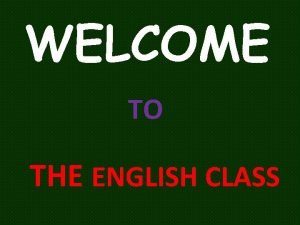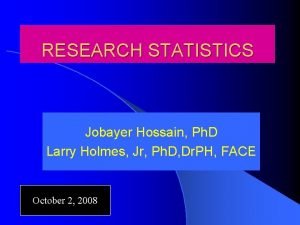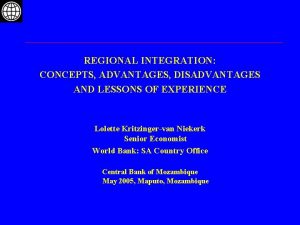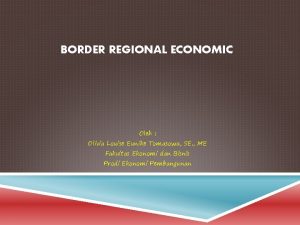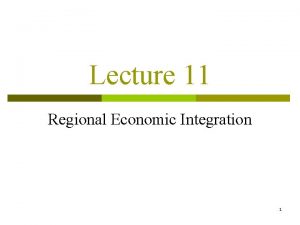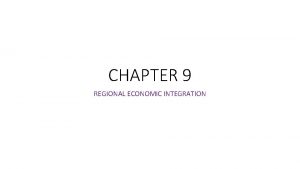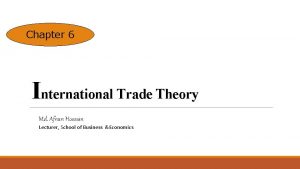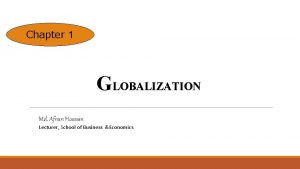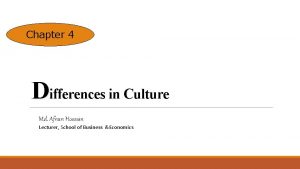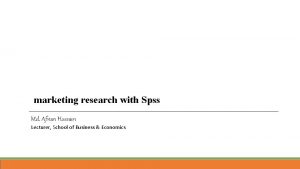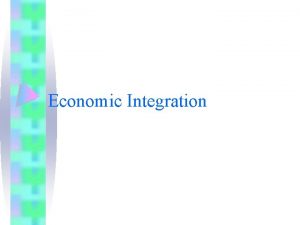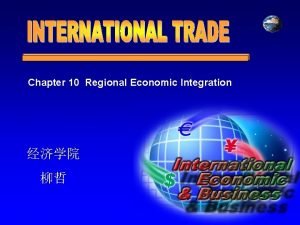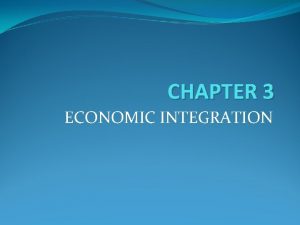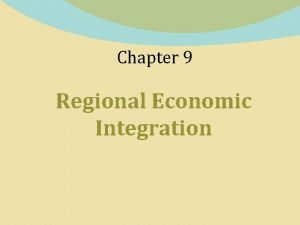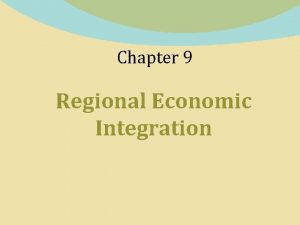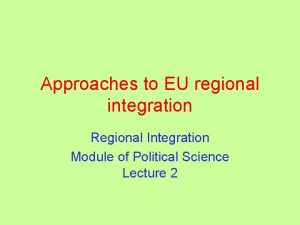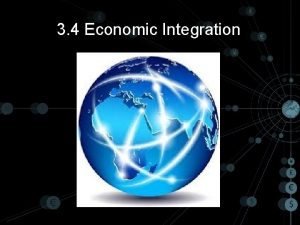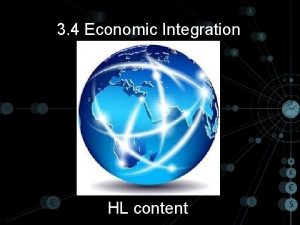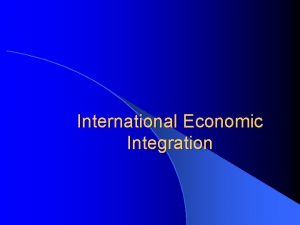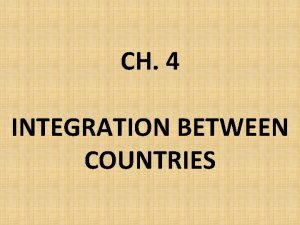Chapter 9 Regional Economic Integration Md Afnan Hossain




















- Slides: 20

Chapter 9 Regional Economic Integration Md. Afnan Hossain Lecturer, School of Business &Economics

Learning Objectives o Regional Economic Integration o Levels of Economic Integration o EURO- the establishment, benefits and costs o NAFTA o ASEAN o SAARC o SAFTA

Regional Economic Integration ØRegional economic integration refers to an economic arrangement between different nations marked by the reduction of or elimination of trade barriers and the coordination of monetary and fiscal policies. ØThe aim of economic integration is to reduce costs for both consumers and producers, as well as, increase trade between the countries taking part in the agreement. 3

Monetary Policy & Fiscal Policy Monetary Policy: Monetary policy is the process by which the monetary authority of a country controls the supply of money, often targeting an inflation rate or interest rate to ensure price stability and general trust in the currency. Fiscal Policy: Fiscal policy is the means by which a government adjusts its spending levels and tax rates to monitor and influence a nation's economy. It is the sister strategy to monetary policy 4

Levels of Economic Integration There are five levels of economic integration: 1. A free trade area eliminates all barriers to the trade of goods and services among member countries, but members determine their own trade policies for nonmembers E. g. the European Free Trade Association (between Norway, Iceland, Liechtenstein, and Switzerland), and the North American Free Trade Agreement (between the U. S. , Canada, and Mexico) are both free trade areas. This is the least integrated. 5

Levels of Economic Integration 2. A customs union eliminates trade barriers between member countries and adopts a common external trade policy The Andean Pact (between Bolivia, Columbia, Ecuador and Peru) is an example of a customs union Customs Union=Free Trade Area + Common External Trade Policy 6

Levels of Economic Integration 3. A common market has no barriers to trade between member countries, a common external trade policy, and the free movement of the factors of production MERCOSUR (Southern Common Market formed between Brazil, Argentina, Paraguay, and Uruguay) is aiming for common market status Common Market= Customs Union + free movement of the factors of production 7

Levels of Economic Integration 4. An economic union has the free flow of products and factors of production between members, a common external trade policy, a common currency, a harmonized tax rates, and a common monetary and fiscal policy The European Union (EU) is an economic union, although an imperfect one since not all members of the EU have adopted the euro, and differences in tax rates across countries still remain Economic Union= Common Market + common currency+ common tax rate + common monetary and fiscal policies 8

Levels of Economic Integration 5. A political union involves a central political apparatus that coordinates the economic, social, and foreign policy of member states The EU is headed toward at least partial political union, and the United States is an example of even closer political union. Political Union= Economic Union + common economic, political and foreign policy This is the most integrated. 9

European Union 10

Levels of Economic Integration 11

Maastricht Treaty The Maastricht Treaty (signed on Feb 22, 1992) committed the EU to adopt a single currency by January 1, 1999. By adopting the euro, the EU has created the second largest currency zone in the world after that of the U. S. dollar The euro is used by 19 of the 28 member states For now, four EU countries-United Kingdom, Denmark, Poland Sweden, that are eligible to participate in the euro-zone, are opting out. 12

Benefits of the Euro Single currency -there are savings from having to handle one currency, rather than many. (Savings from lower foreign exchange) A common currency will make it easier to compare prices across Europe => competition and lower prices => substantial gain for the European consumers European producers will be forced to look for ways to reduce their production costs in order to maintain their profit margins It should give a strong boost to the development of highly liquid pan-European capital market A pan-European euro denominated capital market will increase the range of investment options open both to individuals and institutions 13

Costs of the Euro National authorities lose control over the monetary policy- The Maastricht Treaty required establishment of the ECB (European Central Bank) to mandate interest rate and monetary policy across the Euro zone and to be independent from political pressure. The EU is not an optimal currency area (an area where similarities in the underlying structure of economic activities make it feasible to adopt a single currency and use a single exchange rate as an instrument of macro-economic policy). E. g. Finland Portugal have different wage rates, tax regimes and business cycles and they may react very differently to external economic shocks. 14

The North American Free Trade Agreement (NAFTA) The North American Free Trade Area (NAFTA) formed in January 1, 1994 NAFTA’s participants are the United States, Canada, and Mexico 15

The North American Free Trade Agreement (NAFTA) NAFTA’s Contents: üabolish tariffs on 99 percent of the goods traded between members üremove most barriers on the cross-border flow of services üprotect intellectual property rights üremove most restrictions on FDI between the three member countries üallow each country to apply its own environmental standards, provided such standards have a scientific base üestablish two commissions to impose fines and remove trade privileges when environmental standards or legislation involving health and safety, minimum wages or child labor are ignored 16

Association of South East Asian Nations (ASEAN) The Association of Southeast Asian Nations (ASEAN): It was formed in 1967 It currently includes Brunei, Indonesia, Malaysia, Philippines, Singapore, Thailand, Vietnam, Myanmar, Cambodia, and Laos. The first six are the original members. It wants to foster freer trade between member countries and to achieve some cooperation in their industrial policies An ASEAN Free Trade Area (AFTA) between the six original members of ASEAN came into effect in 2003. 17

The South Asian Association for Regional Cooperation (SAARC) is an economic and geopolitical organization of eight countries that are primarily located in South Asia. The SAARC Secretariat is based in Kathmandu, Nepal. The idea was first raised in 2 May 1980 by the Bangladesh President and the first summit was held in Dhaka on 8 December 1985, when the organization was established by the governments of Bangladesh, Bhutan, India, Maldives, Nepal, Pakistan, and Sri Lanka. Since then the organization has expanded by accepting one new full member, Afghanistan. 18

The South Asian Free Trade Area (SAFTA) is an agreement reached on 6 January 2004 at the 12 th SAARC Summit in Islamabad, Pakistan. It created a free trade area of 1. 6 billion people in Afghanistan, Bangladesh, Bhutan, India, Maldives, Nepal, Pakistan and Sri Lanka (as of 2011, the combined population is 1. 8 billion people). The seven foreign ministers of the region signed a framework agreement on SAFTA to reduce customs duty of all traded goods to zero by the year 2016. 19

 Afnan hossain
Afnan hossain What is regionalization
What is regionalization What is this in english
What is this in english Amir hossain progati high school
Amir hossain progati high school Dr afzal hossain
Dr afzal hossain Dr. abid hossain mollah
Dr. abid hossain mollah Bellal hossain
Bellal hossain Bellal hossain
Bellal hossain Bellal hossain
Bellal hossain Md bellal hossain
Md bellal hossain Welcome to english class images
Welcome to english class images Jobayer hossain
Jobayer hossain Advantages and disadvantages of regional integration
Advantages and disadvantages of regional integration Border regional economic
Border regional economic Three dimensions of corporate strategy
Three dimensions of corporate strategy Backwards intergration
Backwards intergration What is simultaneous integration
What is simultaneous integration Different types of economic integration
Different types of economic integration Economic growth vs economic development
Economic growth vs economic development Growth and development conclusion
Growth and development conclusion Economics unit 1 lesson 2 difficult choices
Economics unit 1 lesson 2 difficult choices
